5 Stages of Growing Tomatoes with Pictures 🍅
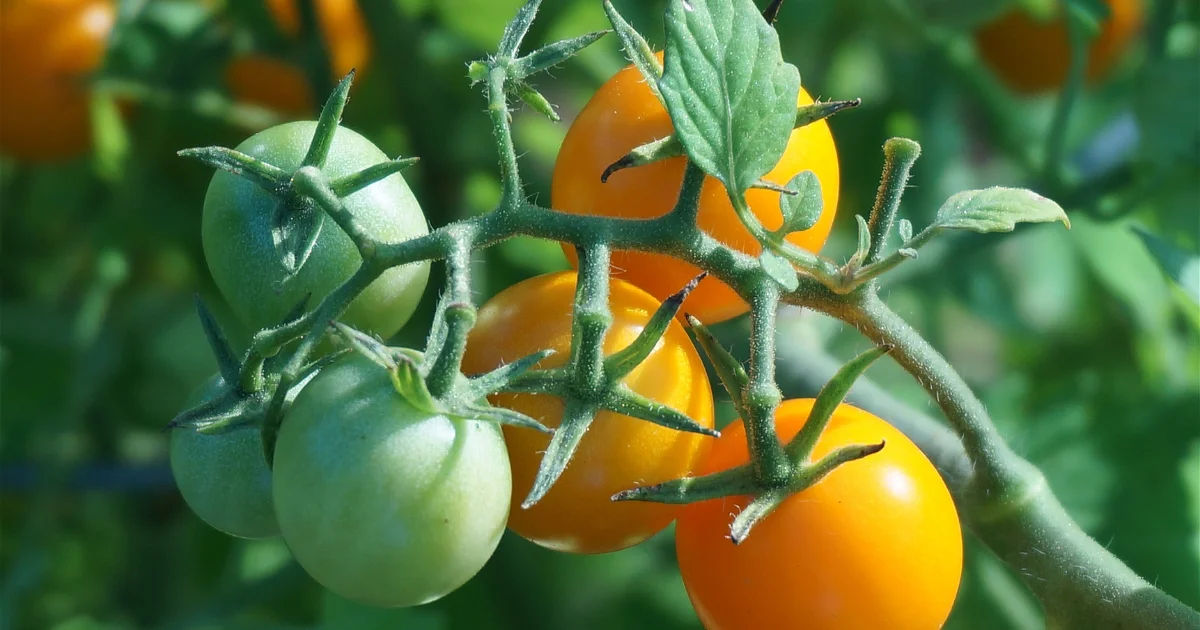
Imagine strolling through your garden, plucking succulent tomatoes 🍅 right off the vine. Whether you’re a seasoned gardener or a budding green thumb, understanding the five stages of tomato growth is key to achieving that dream.
This article provides a detailed look at each stage, complete with photographs that illustrate the transformation of your tomato plants. You’ll learn not only what to expect as your tomatoes grow but also how to provide the best care at every step. Get ready to grow tomatoes that are as delightful to look at as they are to eat!
Discover the Tomato Plant Growth Timeline Visualized in Pictures with Care Tips:
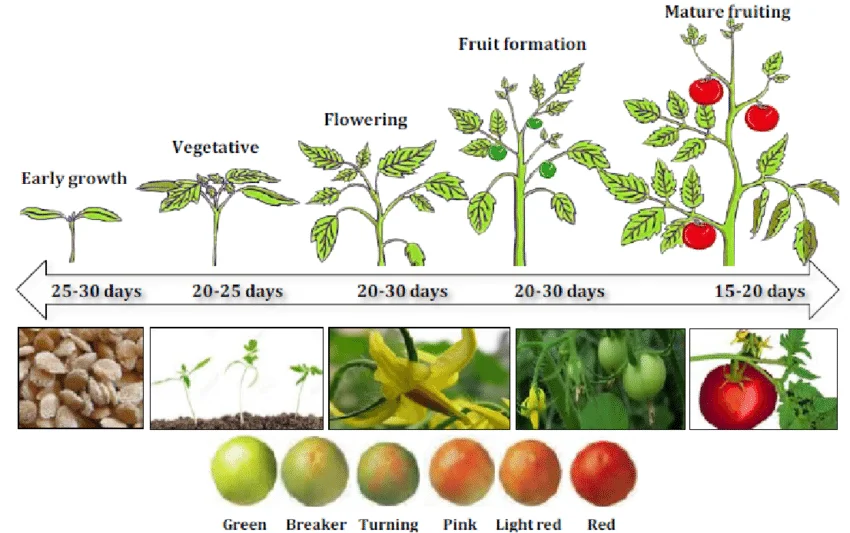
1. Germination
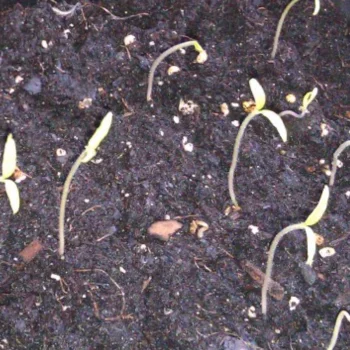
The journey of a tomato plant begins with germination, which occurs when tomato seeds are planted and start to sprout.
This stage typically lasts about 5-10 days and requires warmth, moisture, and oxygen to activate the seeds.
The ideal soil temperature for germination ranges between 70 and 85 degrees Fahrenheit.
Once the seed germinates, it sends out a primary root (radicle) and a shoot that will grow towards the sunlight.
- Plant Size: Seedlings emerge.
- Required Days: 5-10 days.
- Care Tips:
- Maintain soil temperature between 70-85°F (21-29°C).
- Keep soil consistently moist but not soggy.
- Do’s:
- Use a high-quality seed starting mix.
- Provide gentle warmth with a heat mat if necessary.
- Don’ts:
- Don’t let the soil dry out completely.
- Avoid direct sunlight on new seedlings.
Related: How Often to Water Tomato Plants
2. Seedling Stage
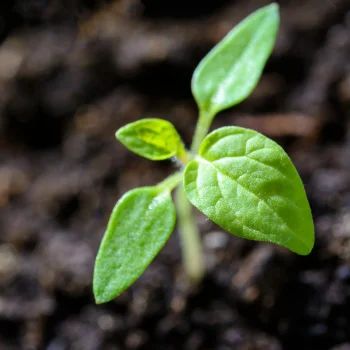
After germination, the seedling stage takes place where the first true leaves develop. This occurs usually within 2-3 weeks after planting.
The initial leaves, called cotyledons, provide nutrients as the true leaves begin to form and take over the role of photosynthesis.
During this stage, it’s important to provide the young plants with plenty of light and keep the soil moist but not waterlogged.
- Plant Size: 2-3 inches tall.
- Required Days: 2-3 weeks post-germination.
- Care Tips:
- Provide at least 14-16 hours of bright light daily.
- Water regularly to keep the soil evenly moist.
- Do’s:
- Begin fertilizing with a diluted liquid fertilizer once true leaves appear.
- Keep seedlings in a stable environment away from drafts.
- Don’ts:
- Don’t overwater or let the seedlings sit in water.
- Avoid handling the delicate stems and roots roughly.
Related: How Far Apart Should I Plant Tomatoes?
3. Vegetative Growth
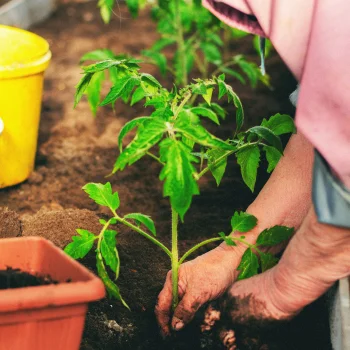
During the vegetative growth stage, the tomato plant focuses on producing more leaves and stems, which support the development of flowers and fruits later.
This stage is marked by rapid growth and requires ample sunlight (at least 6-8 hours daily), water, and nutrients, particularly nitrogen.
Proper spacing and adequate support structures like stakes or cages are also essential to manage the plant’s size and facilitate healthy air circulation.
- Plant Size: Can grow up to 3-6 feet, depending on the variety.
- Required Days: Extends until the first flowers open, typically 6-8 weeks.
- Care Tips:
- Ensure at least 6-8 hours of direct sunlight per day.
- Support plants with stakes or cages as they grow.
- Do’s:
- Regularly check for and remove any suckers to encourage growth.
- Keep the soil rich in nutrients, especially nitrogen during early growth.
- Don’ts:
- Don’t neglect the spacing requirements—plants should be 18-36 inches apart.
- Avoid letting the foliage remain wet for long periods, to prevent disease.
4. Flowering
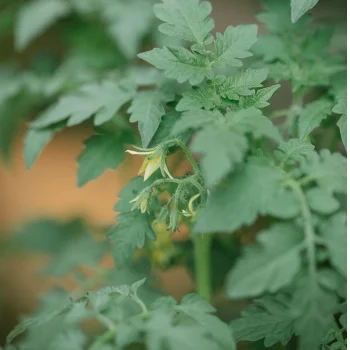
The flowering stage signals the beginning of reproductive growth. Tomato plants start to develop flowers, which are crucial for fruit production.
The flowers typically appear first at the lower parts of the plant and then gradually work upwards.
It’s important during this time to ensure the plants are well-watered and have sufficient nutrients to support flower and fruit formation.
Pollination occurs during this stage, often aided by bees through a process known as buzz pollination.
- Plant Size: Height can be up to 3-6 feet; branching out with flowers.
- Required Days: Lasts 2-3 weeks before fruit sets.
- Care Tips:
- Continue to ensure adequate water and nutrients, especially phosphorus for bloom support.
- Maintain consistent moisture levels in the soil.
- Do’s:
- Encourage pollinators by avoiding heavy pesticide use.
- Hand pollinate if necessary using a small brush to transfer pollen.
- Don’ts:
- Don’t prune heavily once flowering begins.
- Avoid high nitrogen fertilizers which can discourage flowering.
Must Read: Gardening Tools Names and Uses
5. Fruiting and Ripening
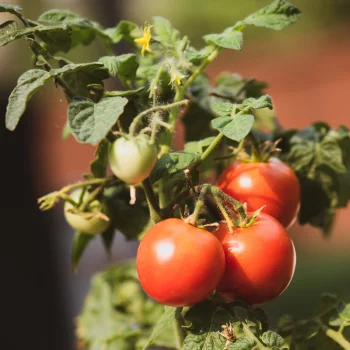
After pollination, the flowers develop into fruits. This stage sees the tomato fruits grow and eventually ripen, changing color from green to red, yellow, or other varieties’ specific colors.
The ripening stage is crucial for developing the tomato’s flavor and texture.
Consistent watering and avoiding excessive moisture fluctuations are important to prevent issues like fruit splitting or blossom end rot.
Once the tomatoes are fully ripened, they are ready to be harvested.
- Plant Size: Continues from the flowering size; fruits develop and grow.
- Required Days: Fruit develops over 20-30 days post-flower; ripening time varies by variety.
- Care Tips:
- Water consistently to prevent splitting or blossom-end rot.
- Shield fruits from extreme sun to prevent scalding.
- Do’s:
- Begin to harvest as soon as tomatoes reach the desired ripeness and color.
- Continue to check for pests and diseases, treating them as necessary.
- Don’ts:
- Don’t pick tomatoes too early; allow them to ripen on the vine for the best flavor.
- Avoid erratic watering schedules which can stress the plants and affect fruit quality
Related: Why Are Tomatoes Flowering But Not Fruiting?
Conclusion
Each stage of tomato growth requires careful attention to environmental conditions like temperature, humidity, and light, as well as regular maintenance tasks such as watering, feeding, and pruning. By understanding and supporting each stage, you can ensure a successful harvest of delicious tomatoes right from your garden.
🍅🍅 Do you have your own tomato-growing tales to tell or thoughts on this article? Please share them in the comments section below—we’d love to hear about your experiences and feedback!
